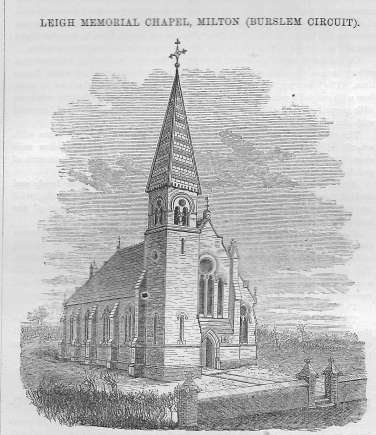Milton Methodist Chapel, Baddeley Road, Burslem
Pevsner - "Really repulsive, The mystery is that this was designed as fitting and accepted as such. Gothic". [Buildings of England, Staffordshire page 267]
Built to replace an earlier chapel in Bagnall Road, Milton, the new chapel was built in 1862-1855 in memory of the Revd. Samuel Leigh, who was born in Milton in 1785, and became the first Methodist Missionary to Australia and New Zealand, 1815-1833. Originally seating 300 and built on a site given by Anthony Shaw of Burslem. The foundstion stone was laid in June 1864 and opened in August1865. The chapel was extended in 1897 and seated 411 in 1940. Based on a photograph in Staffordshire archives the west end of the building had been considerably altered. The spire had been replaced with a saddleback roof and an unfortunate projecting extension added. To the left of the entrance. Permission was granted to build schoolrooms in 1871. Milton Infants’ and Junior School was founded in 1874 in the old chapel, eventually occupying new buildings on a site adjacent to the chapel. However, the old chapel was still being used as a Sunday school in 1958.
BURSLEM - The Wesleyan new chapel at Milton (Leigh memorial), the foundation-stone of which was laid in June, 1864, has been opened for divine worship. The chapel has been named in honour of the late Rev. Samuel Leigh, a native of the village, and the first pioneer of missionary enterprise in New Zealand and Australia. The site was given by Mr. Anthony Shaw, of Newport House, Burslem. The chapel is in white brick and stone, in the Continental Gothic style, with a spire. It stands near the turnpike road leading from Stoke to Leek, a short distance from the old chapel, and has been built from the plans and designs of Messrs. Ward & Ford, architects, Hanley and Burslem. Mr. Thomas Cope, of Smallthorn, was the contractor for the works. The cost, it is said, will be about £1,000, and the building is calculated to seat 300 persons. [Builder 26 August 1865 page 613]
Reference Builder 26 August 1865 page 613
